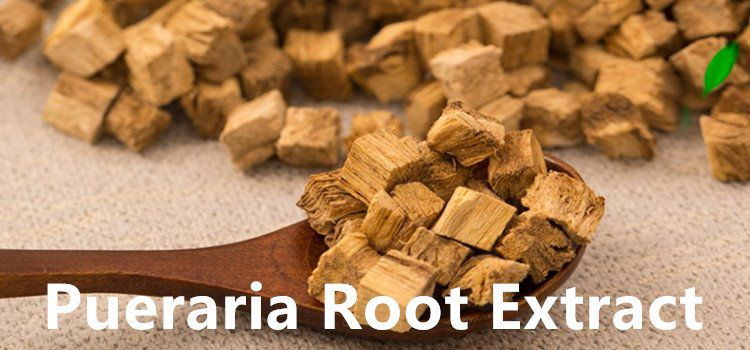The magical effects of Pueraria
1. Basic introduction of Pueraria root
Pueraria lobata, a leguminous plant, is a kind of commonly eaten vegetable in some provinces and regions in southern China. It tastes sweet and cool, and is often used for soup. Its main component is starch. In addition, it contains about 12%25 of flavonoids, including more than 10 kinds of daidzein, daidzein, puerarin, etc.; it also contains carrotin, amino acids, coumarins, etc. Can be used as medicine. As early as the period of Yao, Shun and Yu, people have already started to use Pueraria vines to make hemp and weave cloth. In 1972, three pieces of Gebu fragments were unearthed in Caoxie Mountain, Wuxian County, Jiangsu Province, which were made in the Neolithic Age and are still exquisitely crafted today. These three pieces of Gebu are reliable witnesses that my country has begun to use Pueraria 6,000 years ago.
There are ginseng in the north and Pueraria root in the south, so the four types of people benefit a lot from eating Pueraria root powder. As a food and medicine with the same origin, Pueraria root was very famous in the Eastern Jin Dynasty. It is said that Ge Hong hurriedly drove away a plague among the local people. Therefore, people named it Pueraria Puerariae after various names. A precious tonic suitable for all ages. Since ancient times, there has been a saying that there is ginseng in the north and Pueraria root in the south. Now research has found that Pueraria root contains 12% flavonoids, such as puerarin, soybean isoflavones, and human body Essential calcium, iron, copper, selenium and other minerals.

2. Composition of Pueraria root
Pueraria Root Extract contains isoflavone components puerarin, puerarin xyloside, daidzein, daidzein, β-sitosterol, arachidic acid, and a large amount of starch (19-20% in fresh Pueraria 25).
3.The nutritional value of Pueraria root
Pueraria root contains 12%25 flavonoids, such as puerarin, daidzein, peanut and other nutrients, as well as protein, amino acid, sugar, and minerals such as iron, calcium, copper, selenium, etc. necessary for the human body. It is a valuable tonic suitable for all, and has the reputation of "thousand-year ginseng". As early as Zhang Zhongjing's "Treatise on Febrile Diseases" in the Han Dynasty, there was a famous prescription "Gegen Decoction", which is still an important prescription for treating symptoms. "Materia Medica Justice" said Pueraria lobata "can best develop the qi of spleen and stomach Qingyang". Pueraria lobata is sweet and slightly pungent, with a delicate scent and cool nature, and enters the spleen and stomach meridian. It has the effects of relieving muscles, promoting yang and clearing rash, antipyretic and promoting body fluid. It is used to treat diarrhea due to spleen deficiency, febrile disease and thirst, mainly treating exogenous fever, head and neck pain, poor measles penetration, febrile disease thirst, diabetes, alcohol poisoning, chest pain and heartache and other diseases. Regular consumption of Pueraria powder can regulate human body functions, enhance physical fitness, improve the body's ability to resist diseases, resist aging and prolong life, and maintain youthful vitality forever. According to modern medical research, Pueraria root flavonoids have anti-cancer, anti-cancer and estrogen-like effects, and can promote women's beauty, especially for middle-aged women and menopausal women.
Puerarin is rich in puerarin and as many as 13 kinds of isoflavones. It is a natural phytoestrogen. Phytoestrogens can promote the development of breasts. For girls who lack estrogen in adolescence, they can supplement the estrogen in their bodies by eating puerarin powder and tablets. Hormones make the breast development more plump and perfect, making the figure more plump. Women who have reached menopause eat Pueraria root powder to supplement the lack of estrogen secretion in the body, keep the body young and energetic, and smooth the skin. Eat together with green papaya, the effect of breast enhancement is better and longer lasting.
Function
1. The effect on the circulatory system
The flavonoids proposed in Pueraria root can increase blood flow in the brain and coronary vessels. After injection of Pueraria flavonoids into the internal carotid artery of anesthetized dogs, the cerebral blood flow increases, and the vascular resistance decreases accordingly, and the effect lasts for 2 to 20 minutes. If intravenous injection, the cerebral blood flow increases slightly, and the contraction of epinephrine and norepinephrine cannot be relieved. Cerebrovascular effect, but for patients with hypertension and arteriosclerosis, it can improve cerebral circulation, and its effect is mild. Pueraria flavonoids and pueraria wine extract injected into the coronary arteries and veins of dogs can increase coronary blood flow and reduce vascular resistance. Giving rats intraperitoneal and subcutaneous injections of pueraria root wine extract and intraperitoneal injection of its water decoction and the crystals proposed in pueraria lobata have protective effects on the cardiac ischemic reaction caused by pituitary hormone. Dogs have no obvious antihypertensive effect. Pueraria decoction (produced in Japan) is reported to have two components of stimulating and inhibiting the heart.
2. It has the effect of lowering blood sugar:
Generally speaking, diabetic patients are caused by long-term high blood sugar, so it is very urgent to lower blood sugar, and Pueraria root powder can play a very thick role in lowering blood samples, because it contains a kind of flavonoids compound, this substance plays a big role in lowering blood sugar;
3. It can well prevent coronary arteriosclerosis caused by hyperlipidemia:
Many people may not believe that pueraria powder is effective in improving coronary arteriosclerosis, but the fact is that it can, because the flavonoids in pueraria powder can reduce myocardial oxygen consumption The volume, and then expand the coronary blood vessels and cerebral blood vessels, so that the flow of coronary blood and cerebral blood flow increases;



